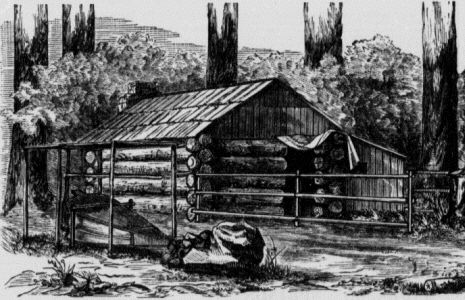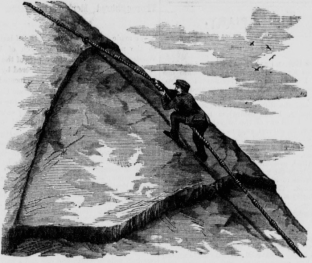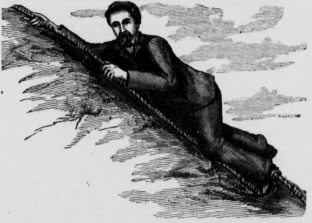This is a transcript of an article from the Pacific Rural Press, a weekly journal published in San Francisco, in which George H. Strong describes his Half Dome ascent in 1881.
The Pacific Rural Press, San Francisco, Saturday, June 18, 1881, p. 431
The Great South Dome, Yosemite Valley.
(Written for the Press by G. H. S.)
In 1874, Prof. Whitney wrote as follows: "The Half or South Dome is a crest of granite rising to the hight of 5,000 ft above the valley, seeming perfectly inaccessible, and being the only one of all the prominent points about the Yosemite which never has been and perhaps never will be trodden by human foot".
A close examination of this elevation shows that the prophecy would appear to be warranted. The valley front is a smooth, nearly vertical flat wall, which gives the name Half Dome. The remainder approaches an oval dome shape, falling off rapidly from the top to 60 degrees, 70 degrees, 80 degrees, and nearly vertical as it goes down toward the valley, and these sides are from 2,000 to 4,000 ft high, except at the rear side, nearly opposite the flat front face. On this side it is approached to within about 2,000 ft by a comparatively easy trail, which diverges some distance above the Nevada fall, from the trail to Cloud's Rest. Upon leaving the woods, the Dome becomes visible for the first time. The first elevation is called "The Saddle". It is a steep narrow ridge, sloping down rapidly to each side, and is very steep upon the ridge itself, but there are many large rocks, some crevices, and an occasional scrubby pine bush by which to hold on until this ascent has been overcome.
Then comes a depression, or saddle, between its highest point and the dome, and this also slopes off, as its name indicates, so as to leave but a narrow standing room in the center. From this point the curved slope of the dome commences, and extends 900 ft to the top. The actual angle is from 38 degrees to 40 degrees, and in some places possibly a little greater, which does not seem very steep when laid out on paper, but when it is in the form of a smooth granite rock, and has, in addition, a slope upon each side, it is bad enough to look up to, and is extremely trying to the nerves to look down at, unless they are pretty steady. The layers of rocks on the sides are in the form of shells, overlapping downward like shingles; whenever there are any breaks, these form steps of from one to two feet high, which must also be surmounted while ascending the incline. This defeated all attempts which were ever made to climb this rock, until October, 1875, when Mr. Geo. G. Anderson succeeded, after two days and a half, in accomplishing the ascent. Mr. Anderson is a Scotchman, who has resided in the valley for 15 years. He is a ship carpenter by trade, and had followed the sea in that business for many years before settling on shore. Before his residence in the valley, he was engaged in putting up one or two suspension bridges over the Tuolumne and other rivers, and acquired considerable local fame for fearlessness and steadiness of nerve. After determining to try the ascent of the dome, he prepared eye-bolts, drills, chisels, and the necessary ropes, and packed them to a convenient place, and after much hard work he reached the top, and planted a flagstaff there. Since that time quite a number of men, and some ladies have climbed the dome, and have been repaid for the risk by the grandest view in the valley.
Last year the rope became unsafe, and was cut to prevent any further attempts and possible accidents. All this excited my interest, and when Anderson offered to accompany me to the Saddle, which he said was as far as we could go, I eagerly accepted the invitation, and this morning, accompanied by a friend, we started at seven o'clock, passing the Vernal Fall, and climbing the steep, narrow trail which surmounts the Nevada Fall, we followed a comparatively easy path toward Cloud's Rest, until we reached a point where we turned off and commenced the ascent toward the Dome. All of this portion of the trail leads through the forest, crossing little streams and some rocks, until we pass the cabin where Anderson lived and prepared the iron work and bolts for his attempts, a picture of which is given [below]. At this season of the year we find many of the peculiar, beautiful snow plants just starting from the ground all along the trail; but as we ascend, these disappear, and the trees become smaller, and finally disappear just at the foot of the Saddle. When we emerged from the timber and caught the first glimpse of the Dome and the Saddle, it appeared like an almost vertical wall of smooth rock and impossible to scale.

At this hight one easily becomes short of breath, and must make frequent stops to recover the breath. We climbed the projecting spur of the Saddle, with considerable difficulty, and took a long rest upon the comparatively flat surface at the top of this elevation. Two hundred and fifty feet or more above us dangled the frayed and ragged end of the rope which had been broken at that point, and after extending, with one or two breaks, some 400 or 500 ft upward, it again terminated, and apparently where it would be most needed.
I had made up my mind before starting that, if possible, I would attempt the ascent, but dared not speak of it to Anderson, fearing that he would not allow it, and when we first came in sight of the place my courage became exceedingly weak, and I was glad that I had not spoken of my intentions to anyone.
After resting a short time, however, I tried to go up a little way, but my boots slipped upon the rocks so that I felt convinced that I could not get up with them on. I then sat down and took off boots and stockings and slung them over my arm for use when I should reach the top, if I ever did. From this point the slope was too steep for the sharp granite sand to lie upon it, and the rock being perfectly smooth, my bare feet would hold upon it so that I could climb with but little difficulty.


Anderson now seemed to divine my intention, for he came up to me and, after gathering a few of the bolts which had been pulled out and were lying at the foot upon the Saddle, and selecting some of the best of the pieces of rope which were still lying there, to repair with, we started up, putting in a bolt here and there, and making the rope fast, for it was almost entirely loose from the point where it commenced, to its upper end. We added some rope at the lower end, and worked slowly up, not trusting the rope, as it was very weak in many places. Before we had accomplished half the ascent, the clouds which had been threatening all the forenoon, began to close in around us, and finally a sharp wind began to blow and some flakes of snow and hail to fall, we therefore abandoned the rope and went up the remainder of the distance as fast as we could.
At the top I resumed my shoes, as there is nearly 15 acres of comparatively level space there, and at this time there was a large body of snow upon one portion of it. We found the flagstaff fallen down, and set it up, and then the clouds broke away a little and gave us a magnificent view of the valley. Just under our feet, and apparently so near that we could throw a stone into it, but almost a mile vertically below us, was Mirror lake, while down the valley all the familiar points seemed but a little distance away, but very small. The Cap of Liberty, Mt. Broderick, North Dome, Glacier and Eagle points are all far below us, but in the opposite direction Starr King, Cloud's Rest, Dana, Hoffman and many others tower still farther above us. Near the farther end of the flat vertical face of the Dome the layers of rock project over, as shown in the accompanying engraving. From this point rocks thrown off were 21 seconds by the watch before striking, or rather before the sound came back to us, but it was impossible for me to appreciate the great hight. Standing upon this projecting point within a foot of the edge, I did not feel the hight much more than I would that of the Palace hotel when looking from the parapet. About 100 ft back from the face of the rock there is a fissure from 8 to 15 inches in width and this extends for some hundreds of feet, one end running out to the face; the other I did not see. We threw small stones down this fissure and they rattled down from side to side for nine seconds before they found a resting place. This crack is estimated to be from 600 to 800 ft deep, and if the mass of rock bounded by it is ever detached, it will terminate the existence of the present Mirror lake. We had hardly completed half our hurried inspection when the clouds began to close in around us again. All the distant and higher points were enveloped in dense black clouds, which were rapidly approaching and warned us to get down as soon as possible, but before we were half way down the top of the dome was hidden from sight. After reaching the foot of the Saddle, we again mounted our horses and retraced our steps through the rain, which began to fall heavily. Looking back, the whole of the Dome was entirely hidden from view by the heavy clouds, and as it looked as if it might rain until night we pushed on through it to Snow's hotel, just below the Nevada Fall, and were soon seated by a warm fire doing justice to a dinner which certainly did not lack appreciative appetites. Before our clothes were dry the clouds broke away, and the reflection of the declining sun upon the Nevada Fall brought out a magnificent rainbow, which was at first close to the fall, but before we left had moved out so that it stood some hundreds of feet in front of it, and presented a very novel appearance. During our stay here we examined some books of ferns, which were prepared by Mrs. Snow, and were arranged in an exceedingly artistic manner. Resuming the trail we reached the hotel at eight o'clock, tolerably tired by the long and exciting climb.
As new ropes have been sent to the valley by the commissioners, the South Dome will soon be again accessible to anyone who has nerve and does not mind a little hard work, and it is probable that by another season a flight of steps will be put up, as Mr. Anderson has all the necessary lumber just at the foot of the Saddle, and well protected.